Attached files
| file | filename |
|---|---|
| 8-K - FORM 8-K - WELLS FARGO & COMPANY/MN | f56393e8vk.htm |
| EX-99.1 - EX-99.1 - WELLS FARGO & COMPANY/MN | f56393exv99w1.htm |
Exhibit 99.2
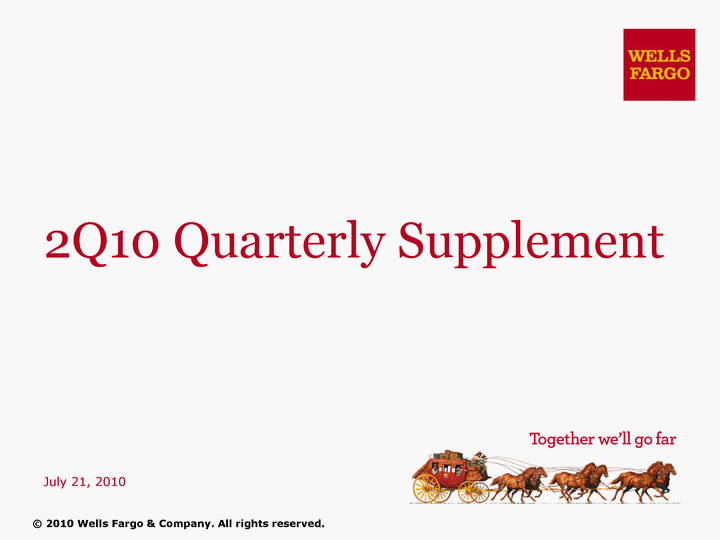
| 2Q10 Quarterly Supplement July 21, 2010 (c) 2010 Wells Fargo & Company. All rights reserved. |
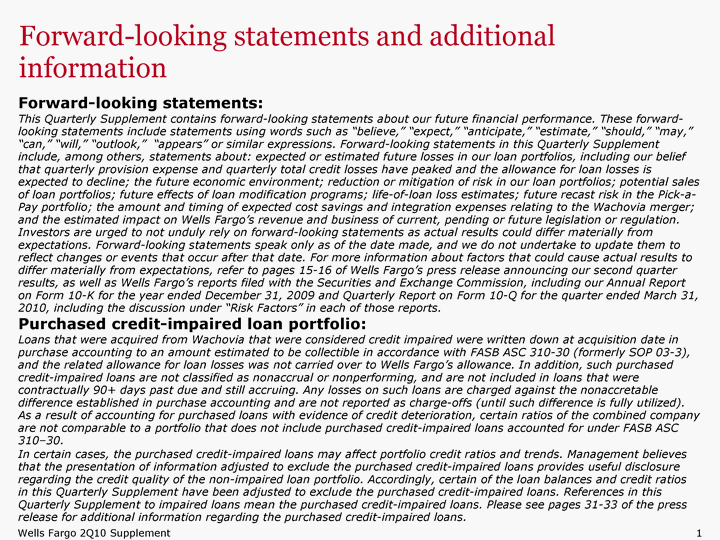
| Forward-looking statements and additional information Forward-looking statements: This Quarterly Supplement contains forward-looking statements about our future financial performance. These forward- looking statements include statements using words such as "believe," "expect," "anticipate," "estimate," "should," "may," "can," "will," "outlook," "appears" or similar expressions. Forward-looking statements in this Quarterly Supplement include, among others, statements about: expected or estimated future losses in our loan portfolios, including our belief that quarterly provision expense and quarterly total credit losses have peaked and the allowance for loan losses is expected to decline; the future economic environment; reduction or mitigation of risk in our loan portfolios; potential sales of loan portfolios; future effects of loan modification programs; life-of-loan loss estimates; future recast risk in the Pick-a- Pay portfolio; the amount and timing of expected cost savings and integration expenses relating to the Wachovia merger; and the estimated impact on Wells Fargo's revenue and business of current, pending or future legislation or regulation. Investors are urged to not unduly rely on forward-looking statements as actual results could differ materially from expectations. Forward-looking statements speak only as of the date made, and we do not undertake to update them to reflect changes or events that occur after that date. For more information about factors that could cause actual results to differ materially from expectations, refer to pages 15-16 of Wells Fargo's press release announcing our second quarter results, as well as Wells Fargo's reports filed with the Securities and Exchange Commission, including our Annual Report on Form 10-K for the year ended December 31, 2009 and Quarterly Report on Form 10-Q for the quarter ended March 31, 2010, including the discussion under "Risk Factors" in each of those reports. Purchased credit-impaired loan portfolio: Loans that were acquired from Wachovia that were considered credit impaired were written down at acquisition date in purchase accounting to an amount estimated to be collectible in accordance with FASB ASC 310-30 (formerly SOP 03-3), and the related allowance for loan losses was not carried over to Wells Fargo's allowance. In addition, such purchased credit-impaired loans are not classified as nonaccrual or nonperforming, and are not included in loans that were contractually 90+ days past due and still accruing. Any losses on such loans are charged against the nonaccretable difference established in purchase accounting and are not reported as charge-offs (until such difference is fully utilized). As a result of accounting for purchased loans with evidence of credit deterioration, certain ratios of the combined company are not comparable to a portfolio that does not include purchased credit-impaired loans accounted for under FASB ASC 310-30. In certain cases, the purchased credit-impaired loans may affect portfolio credit ratios and trends. Management believes that the presentation of information adjusted to exclude the purchased credit-impaired loans provides useful disclosure regarding the credit quality of the non-impaired loan portfolio. Accordingly, certain of the loan balances and credit ratios in this Quarterly Supplement have been adjusted to exclude the purchased credit-impaired loans. References in this Quarterly Supplement to impaired loans mean the purchased credit-impaired loans. Please see pages 31-33 of the press release for additional information regarding the purchased credit-impaired loans. |
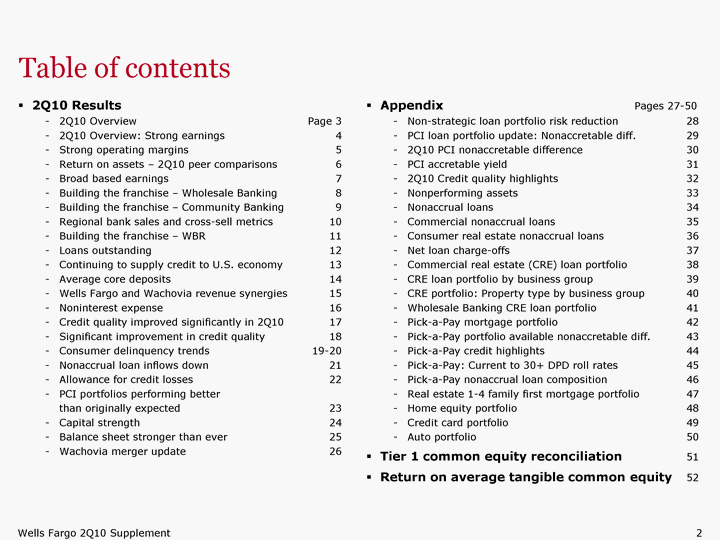
| Table of contents 2Q10 Results 2Q10 Overview Page 3 2Q10 Overview: Strong earnings 4 Strong operating margins 5 Return on assets - 2Q10 peer comparisons 6 Broad based earnings 7 Building the franchise - Wholesale Banking 8 Building the franchise - Community Banking 9 Regional bank sales and cross-sell metrics 10 Building the franchise - WBR 11 Loans outstanding 12 Continuing to supply credit to U.S. economy 13 Average core deposits 14 Wells Fargo and Wachovia revenue synergies 15 Noninterest expense 16 Credit quality improved significantly in 2Q10 17 Significant improvement in credit quality 18 Consumer delinquency trends 19-20 Nonaccrual loan inflows down 21 Allowance for credit losses 22 PCI portfolios performing better than originally expected 23 Capital strength 24 Balance sheet stronger than ever 25 Wachovia merger update 26 Appendix Pages 27-50 Non-strategic loan portfolio risk reduction 28 PCI loan portfolio update: Nonaccretable diff. 29 2Q10 PCI nonaccretable difference 30 PCI accretable yield 31 2Q10 Credit quality highlights 32 Nonperforming assets 33 Nonaccrual loans 34 Commercial nonaccrual loans 35 Consumer real estate nonaccrual loans 36 Net loan charge-offs 37 Commercial real estate (CRE) loan portfolio 38 CRE loan portfolio by business group 39 CRE portfolio: Property type by business group 40 Wholesale Banking CRE loan portfolio 41 Pick-a-Pay mortgage portfolio 42 Pick-a-Pay portfolio available nonaccretable diff. 43 Pick-a-Pay credit highlights 44 Pick-a-Pay: Current to 30+ DPD roll rates 45 Pick-a-Pay nonaccrual loan composition 46 Real estate 1-4 family first mortgage portfolio 47 Home equity portfolio 48 Credit card portfolio 49 Auto portfolio 50 Tier 1 common equity reconciliation 51 Return on average tangible common equity 52 |
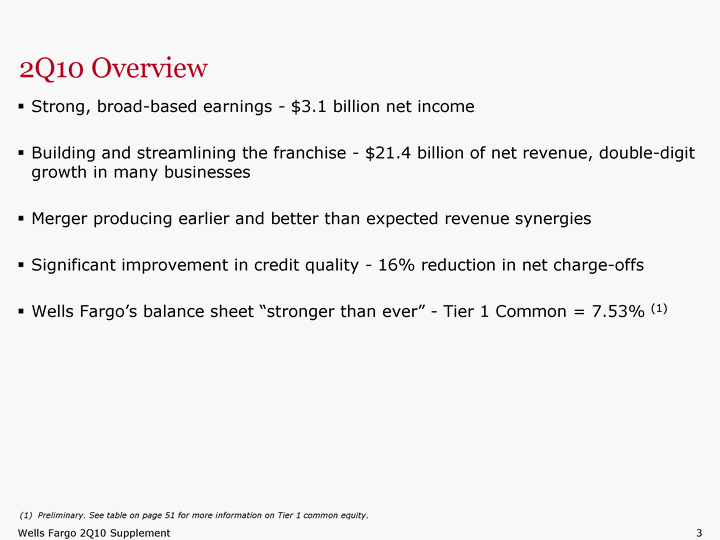
| 2Q10 Overview Strong, broad-based earnings - $3.1 billion net income Building and streamlining the franchise - $21.4 billion of net revenue, double-digit growth in many businesses Merger producing earlier and better than expected revenue synergies Significant improvement in credit quality - 16% reduction in net charge-offs Wells Fargo's balance sheet "stronger than ever" - Tier 1 Common = 7.53% (1) (1) Preliminary. See table on page 51 for more information on Tier 1 common equity. |
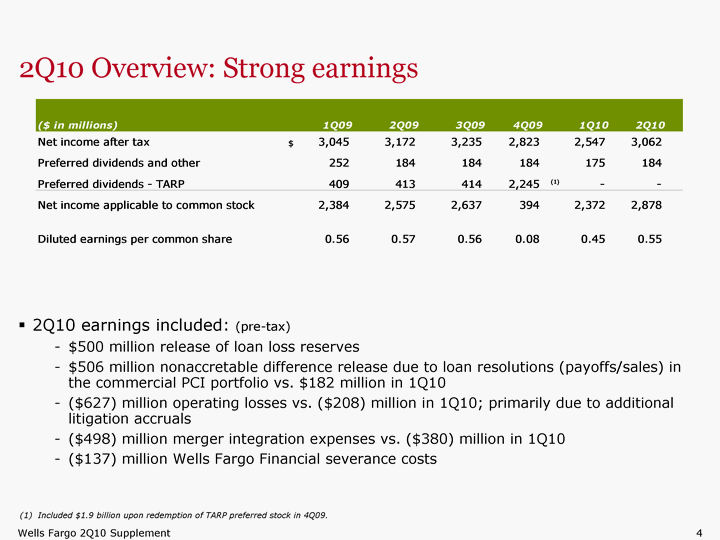
| 2Q10 Overview: Strong earnings 2Q10 earnings included: (pre-tax) $500 million release of loan loss reserves $506 million nonaccretable difference release due to loan resolutions (payoffs/sales) in the commercial PCI portfolio vs. $182 million in 1Q10 ($627) million operating losses vs. ($208) million in 1Q10; primarily due to additional litigation accruals ($498) million merger integration expenses vs. ($380) million in 1Q10 ($137) million Wells Fargo Financial severance costs (1) Included $1.9 billion upon redemption of TARP preferred stock in 4Q09. |
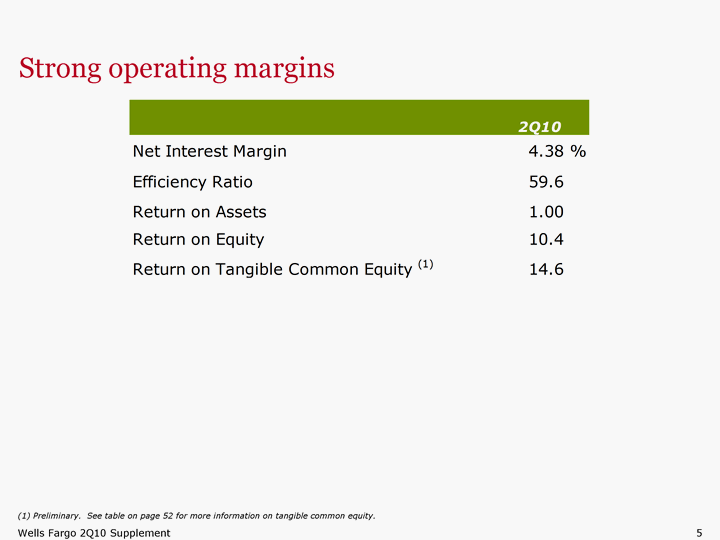
| Strong operating margins (1) Preliminary. See table on page 52 for more information on tangible common equity. |
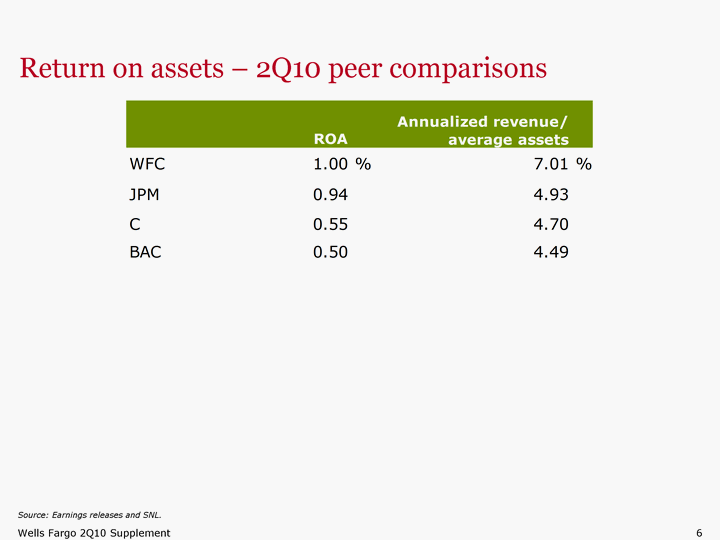
| Return on assets - 2Q10 peer comparisons Source: Earnings releases and SNL. |
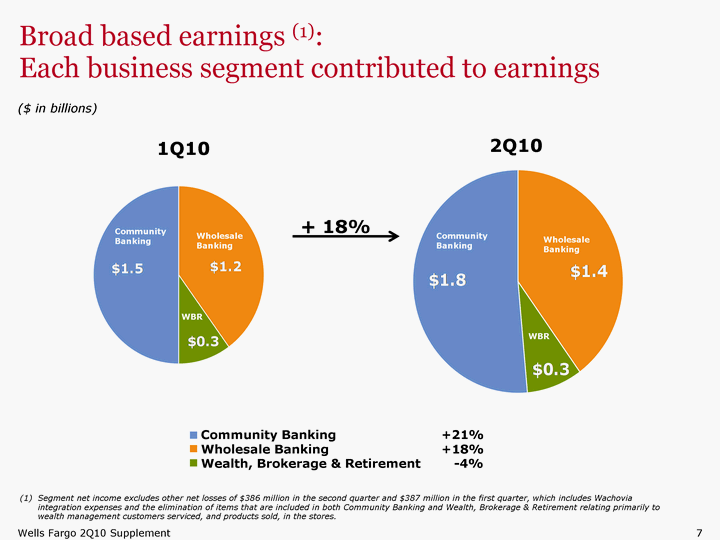
| Broad based earnings (1): Each business segment contributed to earnings ($ in billions) 2Q10 1Q10 Community Banking +21% Wholesale Banking +18% Wealth, Brokerage & Retirement -4% Community Banking WBR Wholesale Banking Community Banking WBR Wholesale Banking + 18% (1) Segment net income excludes other net losses of $386 million in the second quarter and $387 million in the first quarter, which includes Wachovia integration expenses and the elimination of items that are included in both Community Banking and Wealth, Brokerage & Retirement relating primarily to wealth management customers serviced, and products sold, in the stores. |
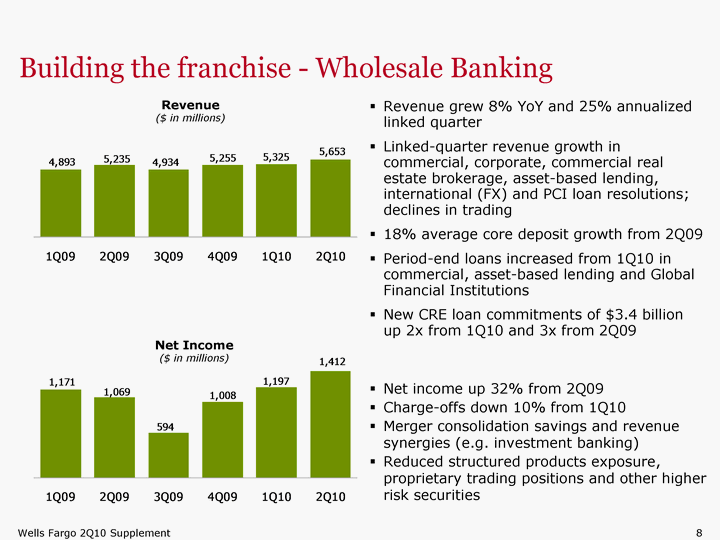
| Building the franchise - Wholesale Banking Revenue grew 8% YoY and 25% annualized linked quarter Linked-quarter revenue growth in commercial, corporate, commercial real estate brokerage, asset-based lending, international (FX) and PCI loan resolutions; declines in trading 18% average core deposit growth from 2Q09 Period-end loans increased from 1Q10 in commercial, asset-based lending and Global Financial Institutions New CRE loan commitments of $3.4 billion up 2x from 1Q10 and 3x from 2Q09 Net income up 32% from 2Q09 Charge-offs down 10% from 1Q10 Merger consolidation savings and revenue synergies (e.g. investment banking) Reduced structured products exposure, proprietary trading positions and other higher risk securities Revenue ($ in millions) Net Income ($ in millions) |
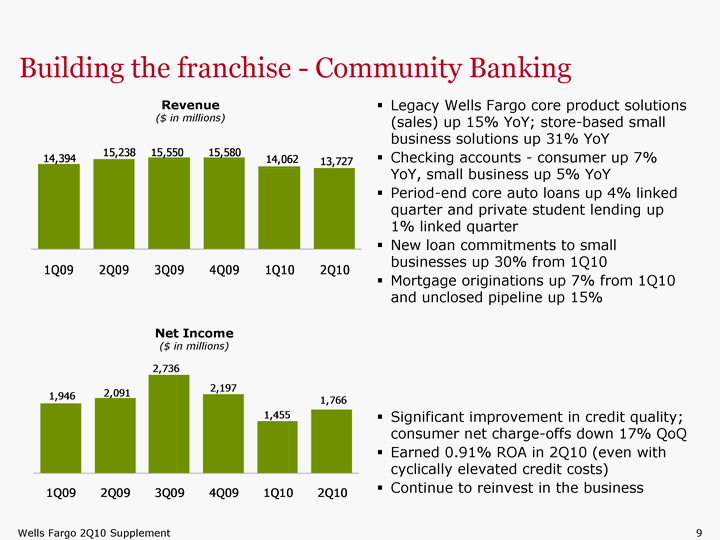
| Building the franchise - Community Banking Legacy Wells Fargo core product solutions (sales) up 15% YoY; store-based small business solutions up 31% YoY Checking accounts - consumer up 7% YoY, small business up 5% YoY Period-end core auto loans up 4% linked quarter and private student lending up 1% linked quarter New loan commitments to small businesses up 30% from 1Q10 Mortgage originations up 7% from 1Q10 and unclosed pipeline up 15% Significant improvement in credit quality; consumer net charge-offs down 17% QoQ Earned 0.91% ROA in 2Q10 (even with cyclically elevated credit costs) Continue to reinvest in the business Revenue ($ in millions) Net Income ($ in millions) |
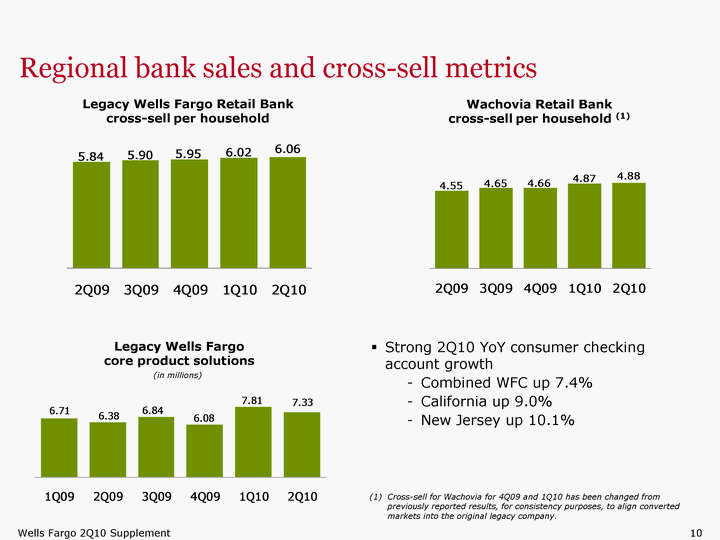
| Regional bank sales and cross-sell metrics Legacy Wells Fargo core product solutions Legacy Wells Fargo Retail Bank cross-sell per household (in millions) Strong 2Q10 YoY consumer checking account growth Combined WFC up 7.4% California up 9.0% New Jersey up 10.1% Wachovia Retail Bank cross-sell per household (1) (1) Cross-sell for Wachovia for 4Q09 and 1Q10 has been changed from previously reported results, for consistency purposes, to align converted markets into the original legacy company. |

| Revenue up 14% since 1Q09 2Q10 revenue included decline of $100 million in deferred compensation hedge income (offset in expenses) vs. 1Q10 and $132 million lower investment securities gain vs. 2Q09 Strong customer deposit inflows; core deposits up 25% since 12/31/08 Client assets up 6% from 2Q09 Managed account assets up 22% Net income up 5% from 2Q09 Expenses in line with revenue Building the franchise - Wealth, Brokerage & Retirement Revenue ($ in millions) Net Income ($ in millions) (1) WBR's 4Q09 net loss included ARS loss reserves. (1) Client Assets ($ in millions) |
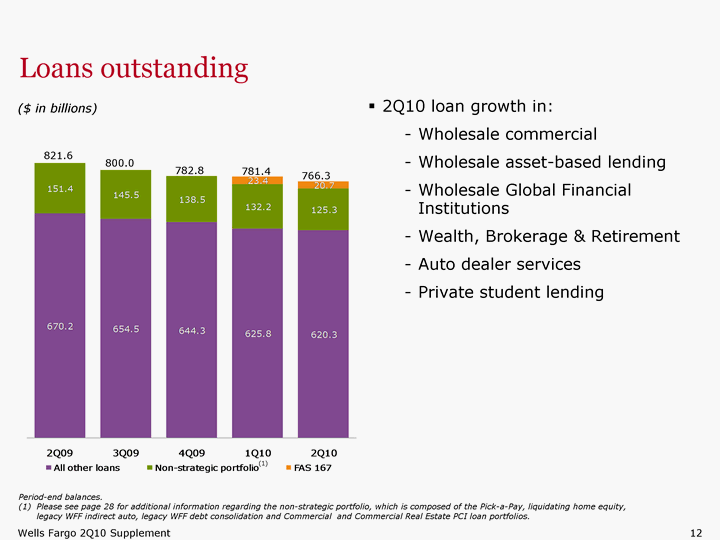
| Loans outstanding 2Q10 loan growth in: Wholesale commercial Wholesale asset-based lending Wholesale Global Financial Institutions Wealth, Brokerage & Retirement Auto dealer services Private student lending ($ in billions) ($ in billions) Period-end balances. (1) Please see page 28 for additional information regarding the non-strategic portfolio, which is composed of the Pick-a-Pay, liquidating home equity, legacy WFF indirect auto, legacy WFF debt consolidation and Commercial and Commercial Real Estate PCI loan portfolios. 821.6 800.0 782.8 781.4 766.3 (1) |
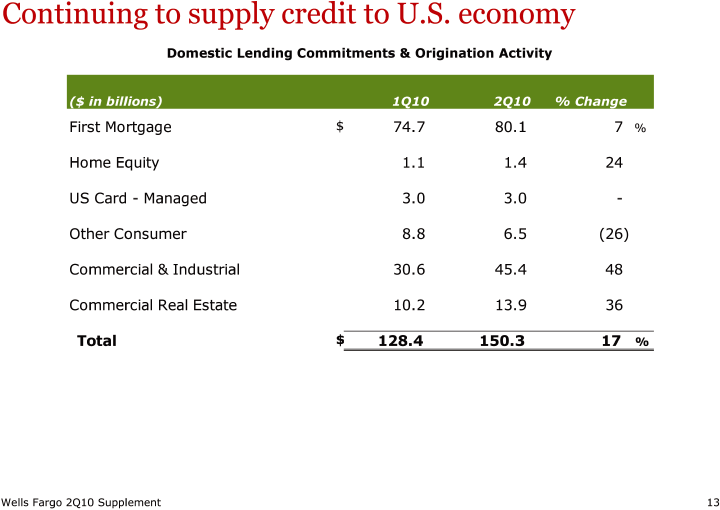
| Continuing to supply credit to U.S. economy Domestic Lending Commitments & Origination Activity |
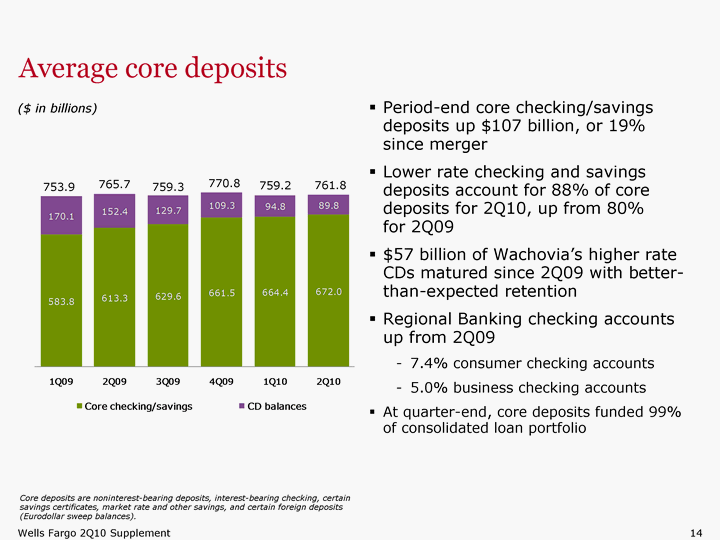
| Average core deposits Period-end core checking/savings deposits up $107 billion, or 19% since merger Lower rate checking and savings deposits account for 88% of core deposits for 2Q10, up from 80% for 2Q09 $57 billion of Wachovia's higher rate CDs matured since 2Q09 with better- than-expected retention Regional Banking checking accounts up from 2Q09 7.4% consumer checking accounts 5.0% business checking accounts At quarter-end, core deposits funded 99% of consolidated loan portfolio Core deposits are noninterest-bearing deposits, interest-bearing checking, certain savings certificates, market rate and other savings, and certain foreign deposits (Eurodollar sweep balances). ($ in billions) 765.7 761.8 759.2 770.8 759.3 753.9 |
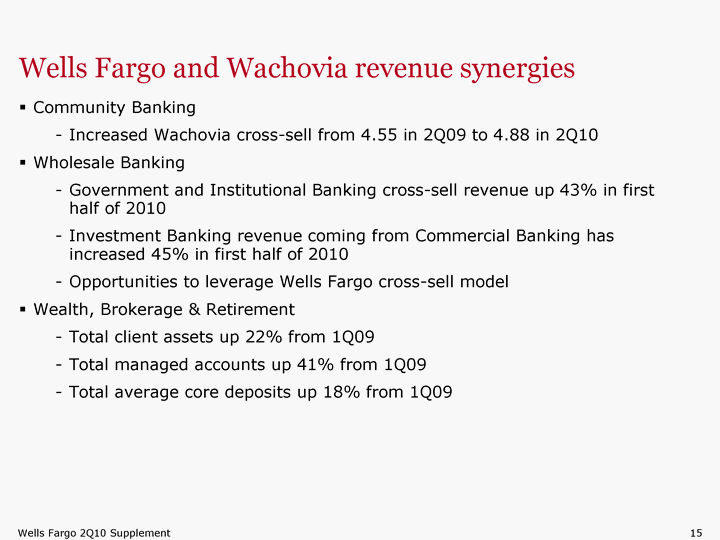
| Wells Fargo and Wachovia revenue synergies Community Banking Increased Wachovia cross-sell from 4.55 in 2Q09 to 4.88 in 2Q10 Wholesale Banking Government and Institutional Banking cross-sell revenue up 43% in first half of 2010 Investment Banking revenue coming from Commercial Banking has increased 45% in first half of 2010 Opportunities to leverage Wells Fargo cross-sell model Wealth, Brokerage & Retirement Total client assets up 22% from 1Q09 Total managed accounts up 41% from 1Q09 Total average core deposits up 18% from 1Q09 |
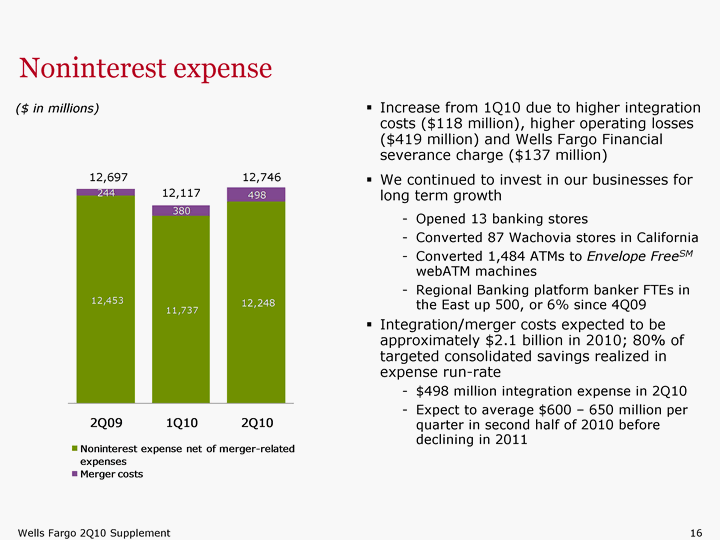
| Noninterest expense Increase from 1Q10 due to higher integration costs ($118 million), higher operating losses ($419 million) and Wells Fargo Financial severance charge ($137 million) We continued to invest in our businesses for long term growth Opened 13 banking stores Converted 87 Wachovia stores in California Converted 1,484 ATMs to Envelope FreeSM webATM machines Regional Banking platform banker FTEs in the East up 500, or 6% since 4Q09 Integration/merger costs expected to be approximately $2.1 billion in 2010; 80% of targeted consolidated savings realized in expense run-rate $498 million integration expense in 2Q10 Expect to average $600 - 650 million per quarter in second half of 2010 before declining in 2011 ($ in millions) 12,746 12,697 12,117 |
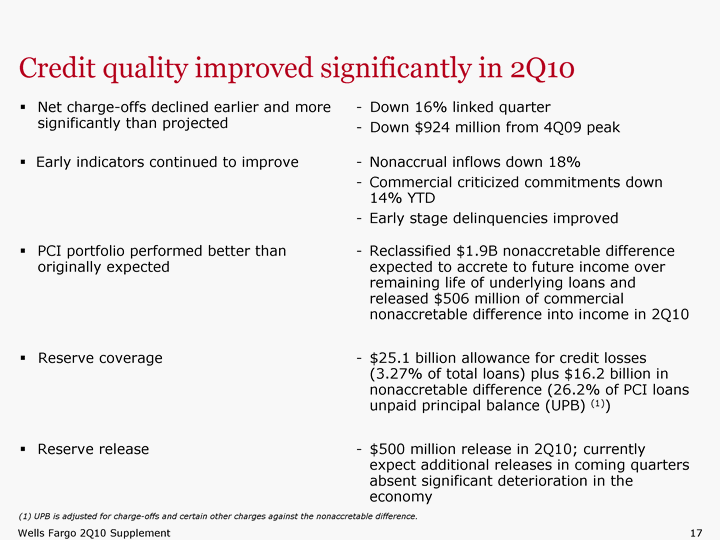
| Credit quality improved significantly in 2Q10 Net charge-offs declined earlier and more significantly than projected Down 16% linked quarter Down $924 million from 4Q09 peak Early indicators continued to improve Nonaccrual inflows down 18% Commercial criticized commitments down 14% YTD Early stage delinquencies improved PCI portfolio performed better than originally expected Reclassified $1.9B nonaccretable difference expected to accrete to future income over remaining life of underlying loans and released $506 million of commercial nonaccretable difference into income in 2Q10 Reserve coverage $25.1 billion allowance for credit losses (3.27% of total loans) plus $16.2 billion in nonaccretable difference (26.2% of PCI loans unpaid principal balance (UPB) (1)) Reserve release $500 million release in 2Q10; currently expect additional releases in coming quarters absent significant deterioration in the economy (1) UPB is adjusted for charge-offs and certain other charges against the nonaccretable difference. |
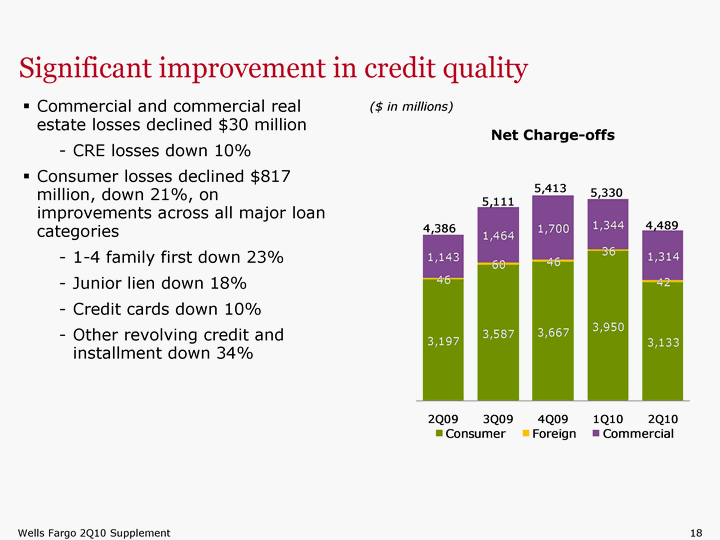
| Significant improvement in credit quality Commercial and commercial real estate losses declined $30 million CRE losses down 10% Consumer losses declined $817 million, down 21%, on improvements across all major loan categories 1-4 family first down 23% Junior lien down 18% Credit cards down 10% Other revolving credit and installment down 34% ($ in millions) Net Charge-offs Net Charge-offs |
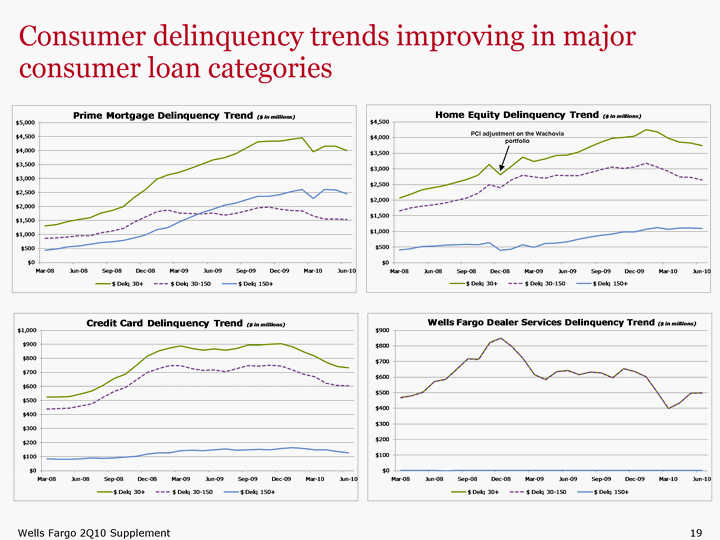
| Consumer delinquency trends improving in major consumer loan categories PCI adjustment on the Wachovia portfolio |

| Pick-a-Pay non-impaired and PCI portfolios continued to perform better than original expectations Pick-a-Pay Non-impaired (Non-PCI) Current To 30 Days Pick-a-Pay Impaired (PCI) Current To 30 Days Early stage delinquencies continued to show stabilization Although 150 plus delinquencies continued to increase as a result of foreclosure avoidance programs, the loans have been written down to net realizable value or evaluated through the allowance for loan losses Roll rates from current to 30+ DPD stabilized in 2Q10 (See page 45) |
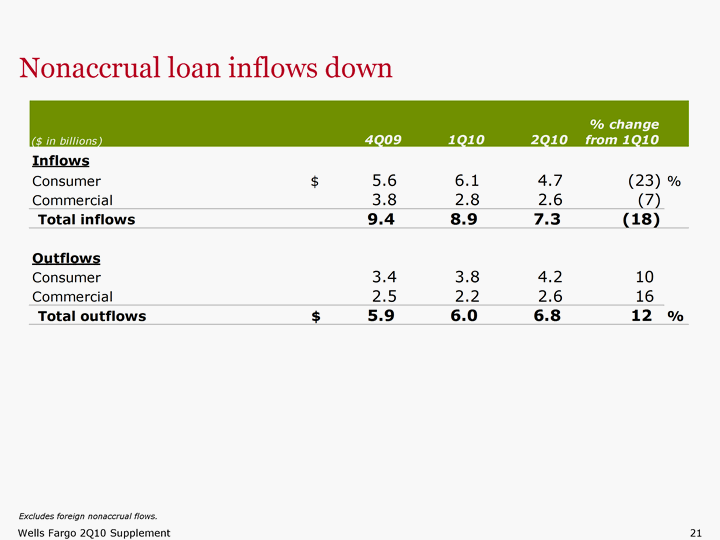
| Nonaccrual loan inflows down Excludes foreign nonaccrual flows. |
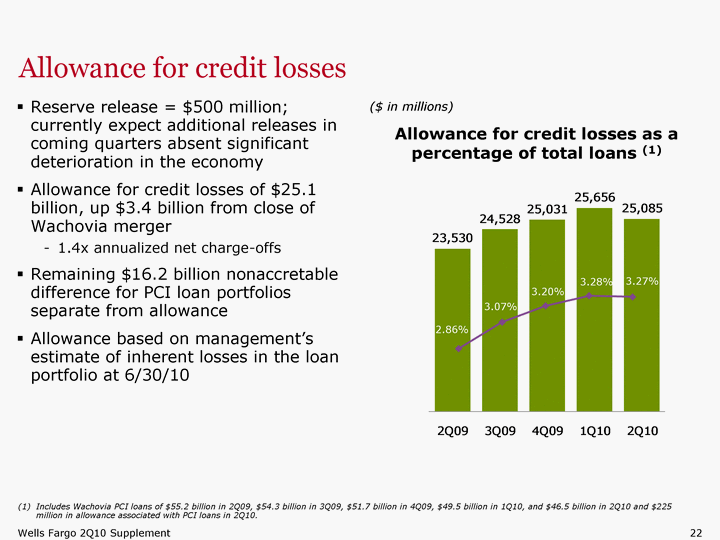
| Allowance for credit losses Reserve release = $500 million; currently expect additional releases in coming quarters absent significant deterioration in the economy Allowance for credit losses of $25.1 billion, up $3.4 billion from close of Wachovia merger 1.4x annualized net charge-offs Remaining $16.2 billion nonaccretable difference for PCI loan portfolios separate from allowance Allowance based on management's estimate of inherent losses in the loan portfolio at 6/30/10 (1) Includes Wachovia PCI loans of $55.2 billion in 2Q09, $54.3 billion in 3Q09, $51.7 billion in 4Q09, $49.5 billion in 1Q10, and $46.5 billion in 2Q10 and $225 million in allowance associated with PCI loans in 2Q10. Allowance for credit losses as a percentage of total loans (1) 3.28% 3.27% 3.20% 3.07% 2.86% ($ in millions) |
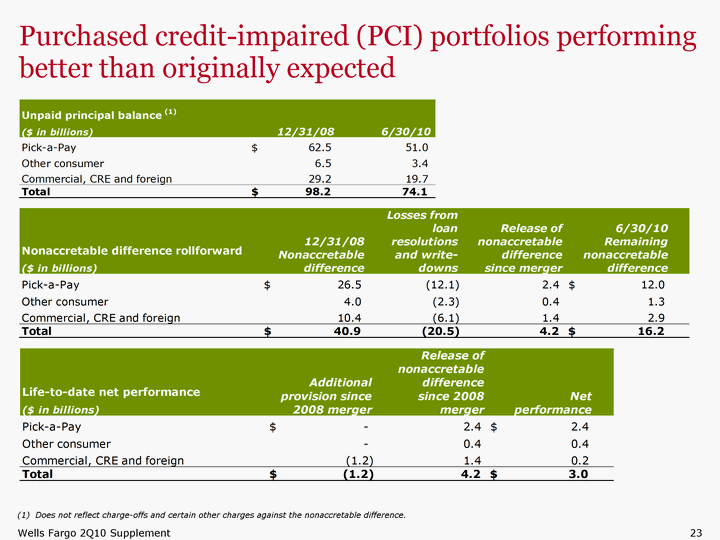
| Purchased credit-impaired (PCI) portfolios performing better than originally expected (1) Does not reflect charge-offs and certain other charges against the nonaccretable difference. |
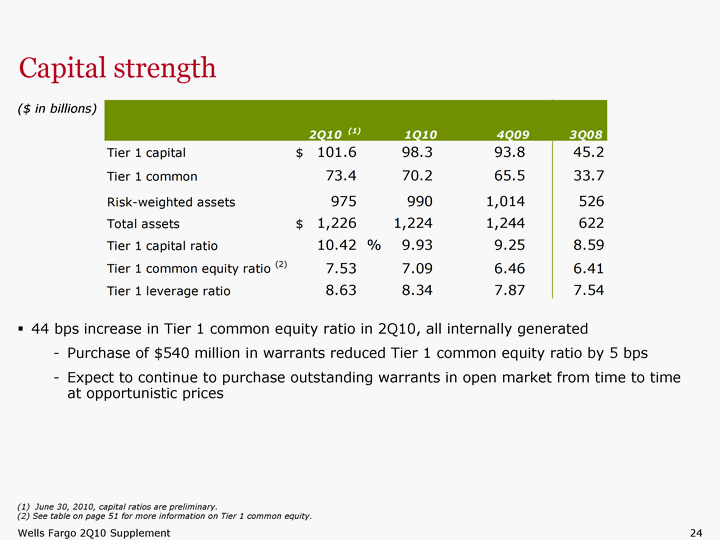
| Capital strength ($ in billions) 44 bps increase in Tier 1 common equity ratio in 2Q10, all internally generated Purchase of $540 million in warrants reduced Tier 1 common equity ratio by 5 bps Expect to continue to purchase outstanding warrants in open market from time to time at opportunistic prices (1) June 30, 2010, capital ratios are preliminary. (2) See table on page 51 for more information on Tier 1 common equity. |
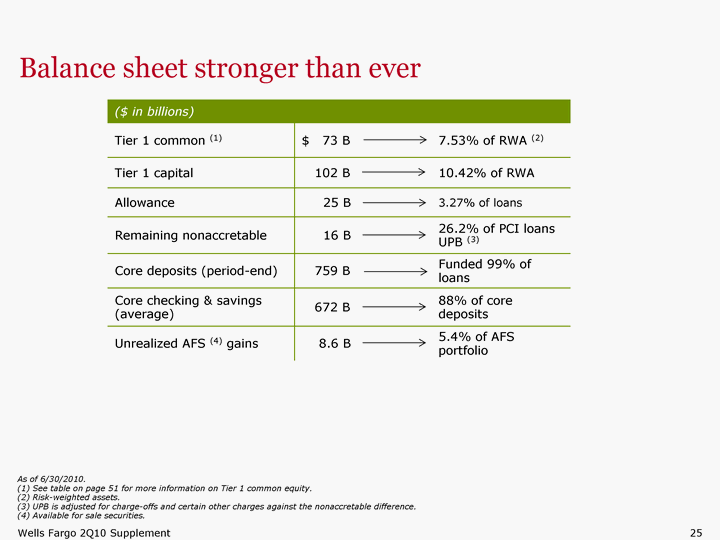
| Balance sheet stronger than ever ($ in billions) Tier 1 common (1) $ 73 B 7.53% of RWA (2) Tier 1 capital 102 B 10.42% of RWA Allowance 25 B 3.27% of loans Remaining nonaccretable 16 B 26.2% of PCI loans UPB (3) Core deposits (period-end) 759 B Funded 99% of loans Core checking & savings (average) 672 B 88% of core deposits Unrealized AFS (4) gains 8.6 B 5.4% of AFS portfolio As of 6/30/2010. (1) See table on page 51 for more information on Tier 1 common equity. (2) Risk-weighted assets. (3) UPB is adjusted for charge-offs and certain other charges against the nonaccretable difference. (4) Available for sale securities. |
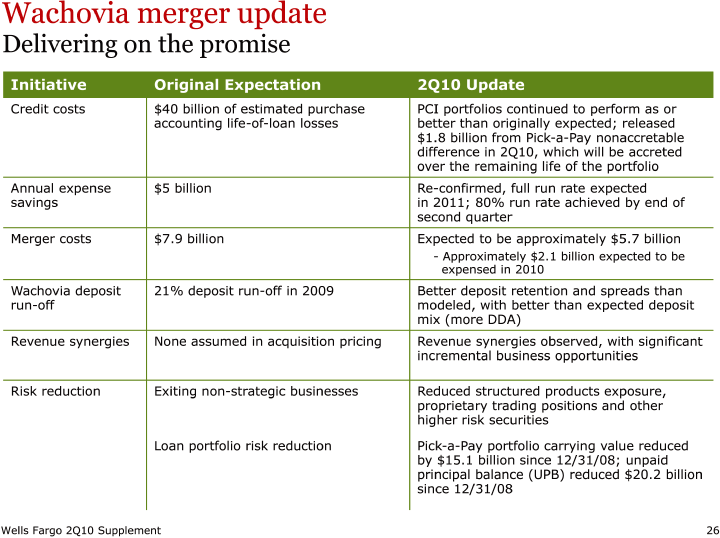
| Wachovia merger update Delivering on the promise Initiative Original Expectation 2Q10 Update Credit costs $40 billion of estimated purchase accounting life-of-loan losses PCI portfolios continued to perform as or better than originally expected; released $1.8 billion from Pick-a-Pay nonaccretable difference in 2Q10, which will be accreted over the remaining life of the portfolio Annual expense savings $5 billion Re-confirmed, full run rate expected in 2011; 80% run rate achieved by end of second quarter Merger costs $7.9 billion Expected to be approximately $5.7 billion - Approximately $2.1 billion expected to be expensed in 2010 Wachovia deposit run-off 21% deposit run-off in 2009 Better deposit retention and spreads than modeled, with better than expected deposit mix (more DDA) Revenue synergies None assumed in acquisition pricing Revenue synergies observed, with significant incremental business opportunities Risk reduction Exiting non-strategic businesses Reduced structured products exposure, proprietary trading positions and other higher risk securities Loan portfolio risk reduction Pick-a-Pay portfolio carrying value reduced by $15.1 billion since 12/31/08; unpaid principal balance (UPB) reduced $20.2 billion since 12/31/08 |

| Appendix |
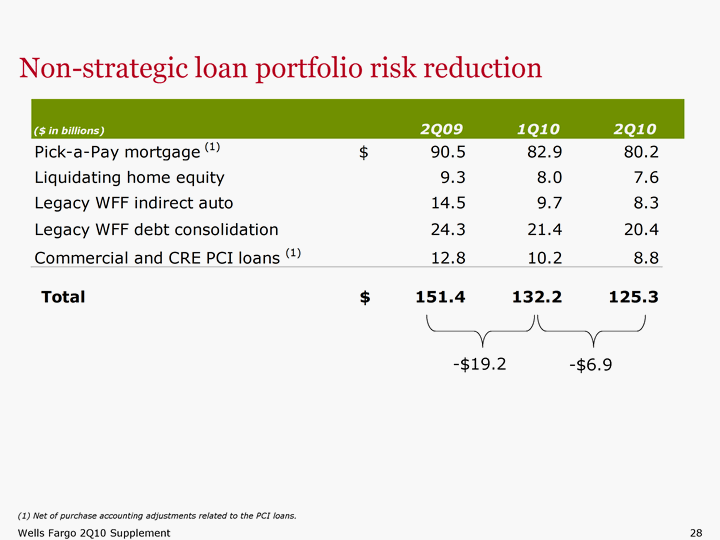
| Non-strategic loan portfolio risk reduction (1) Net of purchase accounting adjustments related to the PCI loans. -$19.2 -$6.9 |
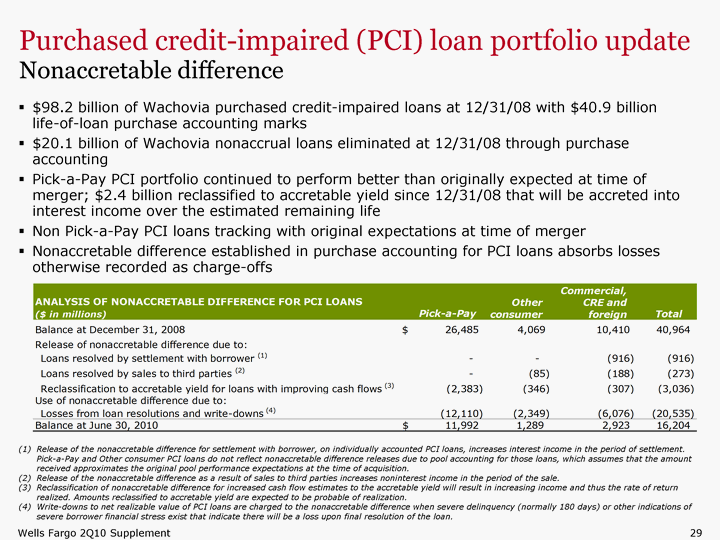
| Purchased credit-impaired (PCI) loan portfolio update Nonaccretable difference $98.2 billion of Wachovia purchased credit-impaired loans at 12/31/08 with $40.9 billion life-of-loan purchase accounting marks $20.1 billion of Wachovia nonaccrual loans eliminated at 12/31/08 through purchase accounting Pick-a-Pay PCI portfolio continued to perform better than originally expected at time of merger; $2.4 billion reclassified to accretable yield since 12/31/08 that will be accreted into interest income over the estimated remaining life Non Pick-a-Pay PCI loans tracking with original expectations at time of merger Nonaccretable difference established in purchase accounting for PCI loans absorbs losses otherwise recorded as charge-offs (1) Release of the nonaccretable difference for settlement with borrower, on individually accounted PCI loans, increases interest income in the period of settlement. Pick-a-Pay and Other consumer PCI loans do not reflect nonaccretable difference releases due to pool accounting for those loans, which assumes that the amount received approximates the original pool performance expectations at the time of acquisition. (2) Release of the nonaccretable difference as a result of sales to third parties increases noninterest income in the period of the sale. (3) Reclassification of nonaccretable difference for increased cash flow estimates to the accretable yield will result in increasing income and thus the rate of return realized. Amounts reclassified to accretable yield are expected to be probable of realization. (4) Write-downs to net realizable value of PCI loans are charged to the nonaccretable difference when severe delinquency (normally 180 days) or other indications of severe borrower financial stress exist that indicate there will be a loss upon final resolution of the loan. |
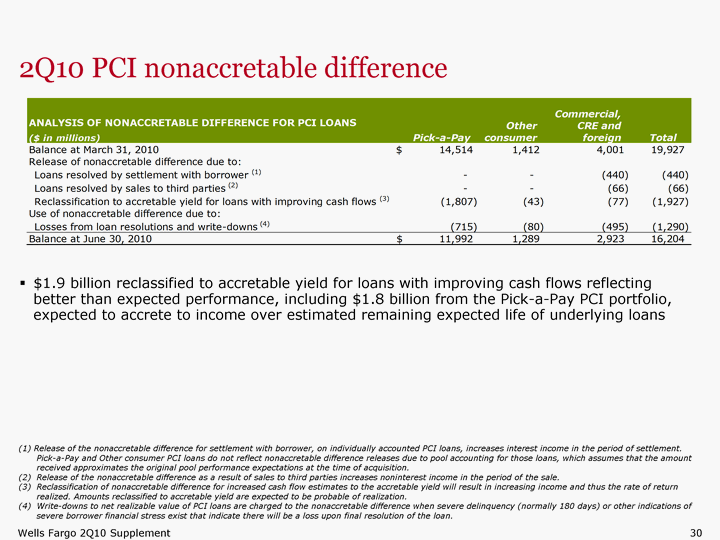
| 2Q10 PCI nonaccretable difference (1) Release of the nonaccretable difference for settlement with borrower, on individually accounted PCI loans, increases interest income in the period of settlement. Pick-a-Pay and Other consumer PCI loans do not reflect nonaccretable difference releases due to pool accounting for those loans, which assumes that the amount received approximates the original pool performance expectations at the time of acquisition. (2) Release of the nonaccretable difference as a result of sales to third parties increases noninterest income in the period of the sale. (3) Reclassification of nonaccretable difference for increased cash flow estimates to the accretable yield will result in increasing income and thus the rate of return realized. Amounts reclassified to accretable yield are expected to be probable of realization. (4) Write-downs to net realizable value of PCI loans are charged to the nonaccretable difference when severe delinquency (normally 180 days) or other indications of severe borrower financial stress exist that indicate there will be a loss upon final resolution of the loan. $1.9 billion reclassified to accretable yield for loans with improving cash flows reflecting better than expected performance, including $1.8 billion from the Pick-a-Pay PCI portfolio, expected to accrete to income over estimated remaining expected life of underlying loans |
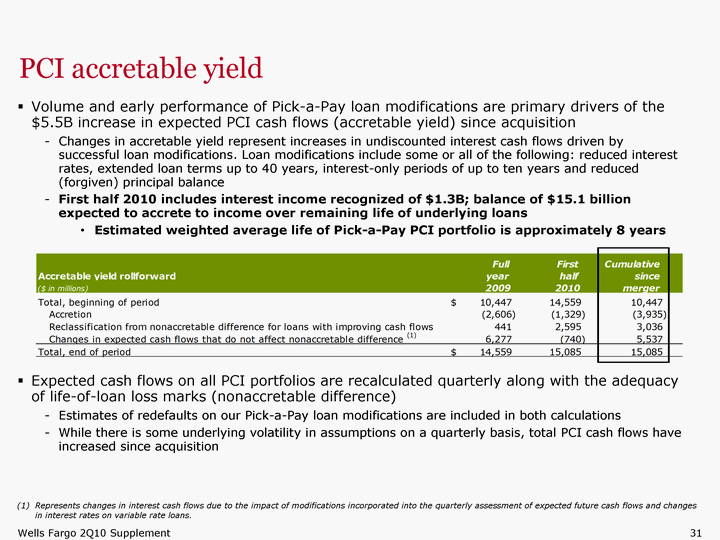
| PCI accretable yield Volume and early performance of Pick-a-Pay loan modifications are primary drivers of the $5.5B increase in expected PCI cash flows (accretable yield) since acquisition Changes in accretable yield represent increases in undiscounted interest cash flows driven by successful loan modifications. Loan modifications include some or all of the following: reduced interest rates, extended loan terms up to 40 years, interest-only periods of up to ten years and reduced (forgiven) principal balance First half 2010 includes interest income recognized of $1.3B; balance of $15.1 billion expected to accrete to income over remaining life of underlying loans Estimated weighted average life of Pick-a-Pay PCI portfolio is approximately 8 years Expected cash flows on all PCI portfolios are recalculated quarterly along with the adequacy of life-of-loan loss marks (nonaccretable difference) Estimates of redefaults on our Pick-a-Pay loan modifications are included in both calculations While there is some underlying volatility in assumptions on a quarterly basis, total PCI cash flows have increased since acquisition (1) Represents changes in interest cash flows due to the impact of modifications incorporated into the quarterly assessment of expected future cash flows and changes in interest rates on variable rate loans. |
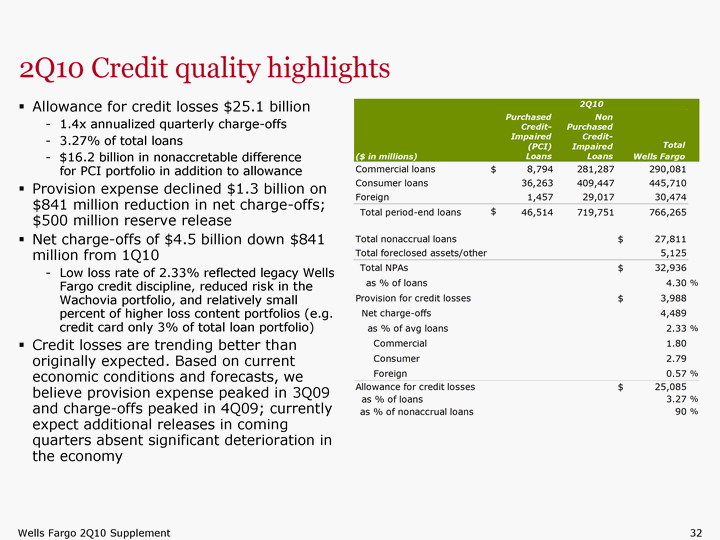
| 2Q10 Credit quality highlights Allowance for credit losses $25.1 billion 1.4x annualized quarterly charge-offs 3.27% of total loans $16.2 billion in nonaccretable difference for PCI portfolio in addition to allowance Provision expense declined $1.3 billion on $841 million reduction in net charge-offs; $500 million reserve release Net charge-offs of $4.5 billion down $841 million from 1Q10 Low loss rate of 2.33% reflected legacy Wells Fargo credit discipline, reduced risk in the Wachovia portfolio, and relatively small percent of higher loss content portfolios (e.g. credit card only 3% of total loan portfolio) Credit losses are trending better than originally expected. Based on current economic conditions and forecasts, we believe provision expense peaked in 3Q09 and charge-offs peaked in 4Q09; currently expect additional releases in coming quarters absent significant deterioration in the economy |
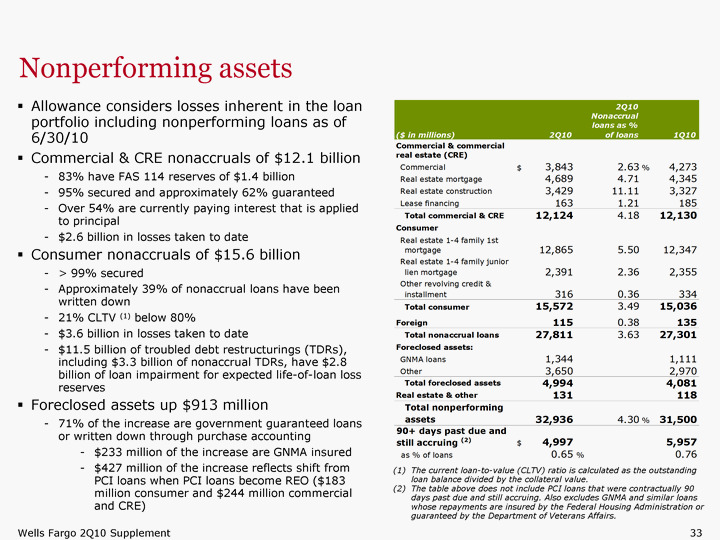
| Nonperforming assets Allowance considers losses inherent in the loan portfolio including nonperforming loans as of 6/30/10 Commercial & CRE nonaccruals of $12.1 billion 83% have FAS 114 reserves of $1.4 billion 95% secured and approximately 62% guaranteed Over 54% are currently paying interest that is applied to principal $2.6 billion in losses taken to date Consumer nonaccruals of $15.6 billion > 99% secured Approximately 39% of nonaccrual loans have been written down 21% CLTV (1) below 80% $3.6 billion in losses taken to date $11.5 billion of troubled debt restructurings (TDRs), including $3.3 billion of nonaccrual TDRs, have $2.8 billion of loan impairment for expected life-of-loan loss reserves Foreclosed assets up $913 million 71% of the increase are government guaranteed loans or written down through purchase accounting $233 million of the increase are GNMA insured $427 million of the increase reflects shift from PCI loans when PCI loans become REO ($183 million consumer and $244 million commercial and CRE) The current loan-to-value (CLTV) ratio is calculated as the outstanding loan balance divided by the collateral value. The table above does not include PCI loans that were contractually 90 days past due and still accruing. Also excludes GNMA and similar loans whose repayments are insured by the Federal Housing Administration or guaranteed by the Department of Veterans Affairs. |

| Nonaccrual loans Overall increase of 2% decelerated significantly from 1Q10 increase of 12% from 4Q09 Real estate (residential and commercial) nonaccruals are up but all other loan types down 10% including a 10% decline in C&I and a 5% decline in revolving credit nonaccruals Pace of inflows (1) declined significantly - inflows down 18% in quarter from 1Q10 with consumer inflows down 23% - while outflows are increasing, up 12% from 1Q10 (1) Please see pages 21, 35 and 36 for additional information on nonaccrual inflows and outflows. |
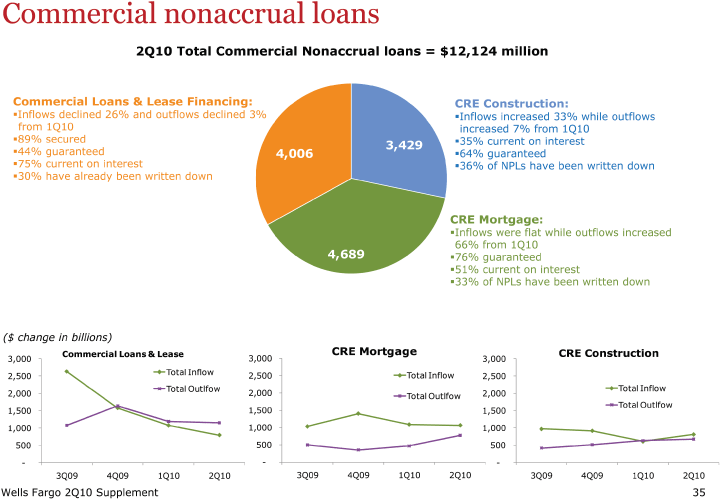
| Commercial nonaccrual loans CRE Construction: Inflows increased 33% while outflows increased 7% from 1Q10 35% current on interest 64% guaranteed 36% of NPLs have been written down CRE Mortgage: Inflows were flat while outflows increased 66% from 1Q10 76% guaranteed 51% current on interest 33% of NPLs have been written down Commercial Loans & Lease Financing: Inflows declined 26% and outflows declined 3% from 1Q10 89% secured 44% guaranteed 75% current on interest 30% have already been written down 2Q10 Total Commercial Nonaccrual loans = $12,124 million ($ change in billions) |

| Consumer real estate nonaccrual loans Home Equity: Inflows declined 20% while outflows declined 15% 18% are TDRs written down to current net realizable value 37% are > 180 DPD Other Businesses: 81% is WFF debt consolidation Inflows declined 9% while outflows remained flat 37% are TDRs written down to current net realizable value 11% is WBR Inflows increased 33% while outflows increased 76% Home Mortgage: Inflows declined 33% while outflows increased 64% 56% have already been written down 20% are TDRs written down to current net realizable value 65% are > 180 DPD Pick-a-Pay: Inflows declined 30% while outflows increased 33% 79% of NPLs held at current estimated recoverable value 19% are TDRs written down to current net realizable value See page 46 for additional information 2Q10 Total Residential Real Estate Nonaccrual loans = $15,256 million ($ change in billions) |
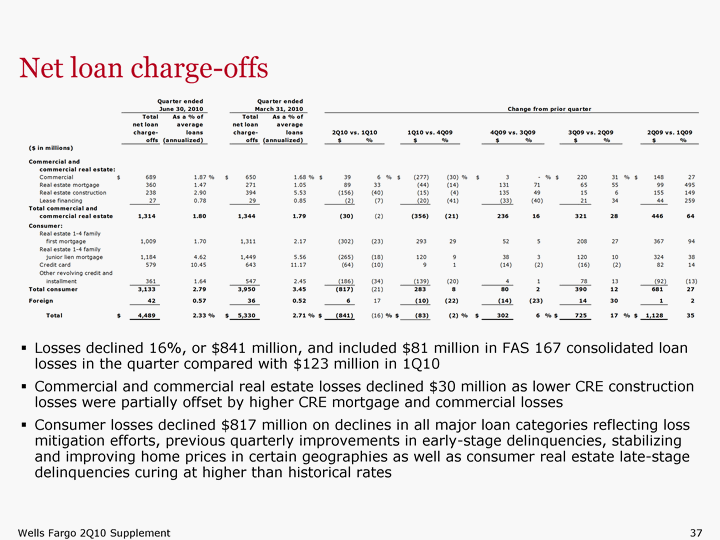
| Net loan charge-offs Losses declined 16%, or $841 million, and included $81 million in FAS 167 consolidated loan losses in the quarter compared with $123 million in 1Q10 Commercial and commercial real estate losses declined $30 million as lower CRE construction losses were partially offset by higher CRE mortgage and commercial losses Consumer losses declined $817 million on declines in all major loan categories reflecting loss mitigation efforts, previous quarterly improvements in early-stage delinquencies, stabilizing and improving home prices in certain geographies as well as consumer real estate late-stage delinquencies curing at higher than historical rates |
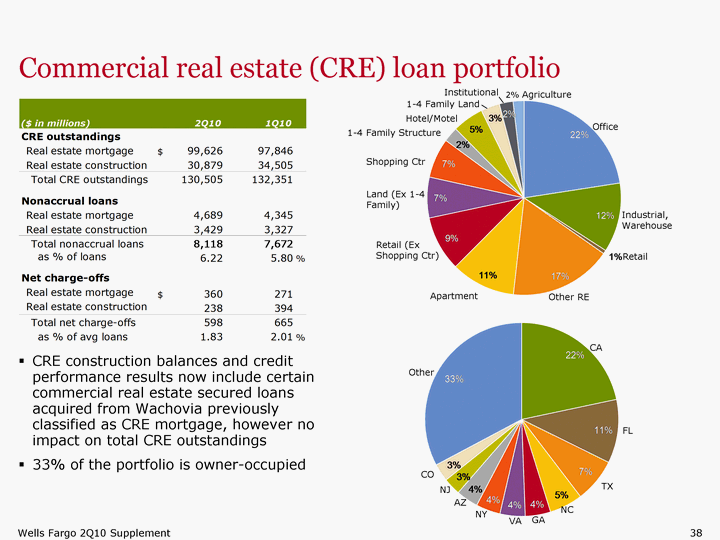
| Commercial real estate (CRE) loan portfolio Office Industrial, Warehouse Other RE Apartment Retail (Ex Shopping Ctr) Land (Ex 1-4 Family) Shopping Ctr 1-4 Family Structure Hotel/Motel 1-4 Family Land Institutional 2% Agriculture Retail CA FL TX NC GA NY VA AZ NJ CO Other CRE construction balances and credit performance results now include certain commercial real estate secured loans acquired from Wachovia previously classified as CRE mortgage, however no impact on total CRE outstandings 33% of the portfolio is owner-occupied |
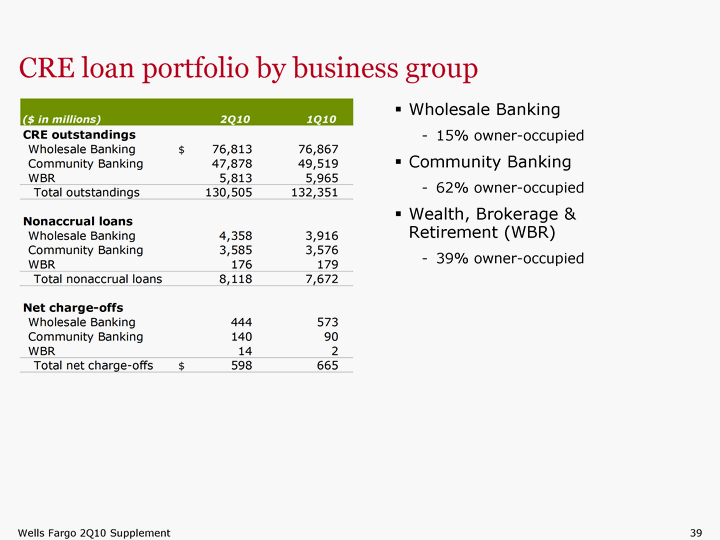
| CRE loan portfolio by business group Wholesale Banking 15% owner-occupied Community Banking 62% owner-occupied Wealth, Brokerage & Retirement (WBR) 39% owner-occupied |

| CRE portfolio: Property type by business group CRE portfolio secured by well-diversified mix of property types across three business groups Balances secured by 1-4 family residential real estate structure & land make up 6% of the portfolio, with higher concentrations in Wealth, Brokerage & Retirement Retail, excluding shopping centers, includes stores, restaurants, and other retail businesses independently located Other real estate is composed of multiple properties (ex. churches, public storage and parking lots) Wholesale Banking Community Banking WBR Office Industrial, Warehouse Other RE Apartment Retail (Ex Shopping Ctr) Land (Ex 1-4 Family) Shopping Ctr 1-4 Family Structure Hotel/Motel 1-4 Family Land Institutional Agriculture Retail As of 6/30/10. Office Industrial, Warehouse Retail (Ex Shopping Ctr) Land (Ex 1-4 Family) Shopping Ctr 1-4 Family Structure Hotel/Motel 1-4 Family Land Institutional Agriculture Retail Other RE Apartment Office Industrial, Warehouse Other RE Apartment Retail (Ex Shopping Ctr) Land (Ex 1-4 Family) Shopping Ctr 1-4 Family Structure Hotel/Motel 1-4 Family Land Agriculture Retail Institutional |

| Wholesale Banking CRE loan portfolio (1) Wholesale CRE outstandings of $83.9 billion (1) down $1.2 billion, or 1%, from 1Q10 Legacy Wells Fargo CRE portfolio = $35.2 billion up $1.2 billion, or 4%, from 1Q10 driven by new loan commitments Losses declined $53 million, or 72 bps, from 1Q10 Wachovia PCI CRE portfolio = $8.8 billion carrying value down $1.2 billion, or 12%, from 1Q10 Losses remained relatively stable, down $8 million, from 1Q10 2Q10 revenue included release of nonaccretable difference for commercial PCI resolutions (payoffs/sales) of $495 million in the quarter vs. $162 million in 1Q10, release of nonaccretable difference on improved borrower liquidity and higher collateral asset values in the quarter; nearly 50% of the 2Q10 resolutions were attributable to 2 loans Foreclosed assets/REO/Other increased $239 million from 1Q10 Wachovia non-PCI CRE portfolio = $26.4 billion down $1.1 billion, or 4%, from 1Q10 Losses declined $26 million, or 33 bps, from 1Q10 CRE loans originated through other Wholesale Banking channels (both legacy Wells Fargo and Wachovia) = $13.5 billion Losses and nonaccruals relatively stable from 1Q10 Includes $7.1 billion in C&I loans managed by commercial real estate business including unsecured loans to real estate developers not secured by real estate and loans to REITs, as well as foreign and consumer loans. |
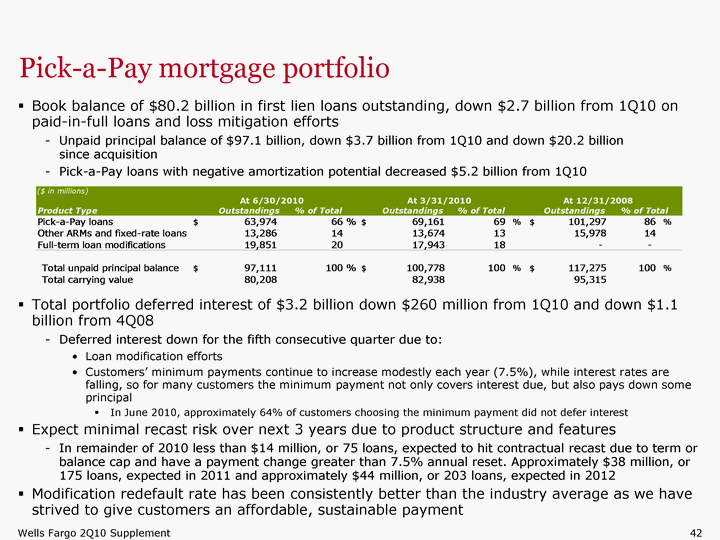
| Pick-a-Pay mortgage portfolio Book balance of $80.2 billion in first lien loans outstanding, down $2.7 billion from 1Q10 on paid-in-full loans and loss mitigation efforts Unpaid principal balance of $97.1 billion, down $3.7 billion from 1Q10 and down $20.2 billion since acquisition Pick-a-Pay loans with negative amortization potential decreased $5.2 billion from 1Q10 Total portfolio deferred interest of $3.2 billion down $260 million from 1Q10 and down $1.1 billion from 4Q08 Deferred interest down for the fifth consecutive quarter due to: Loan modification efforts Customers' minimum payments continue to increase modestly each year (7.5%), while interest rates are falling, so for many customers the minimum payment not only covers interest due, but also pays down some principal In June 2010, approximately 64% of customers choosing the minimum payment did not defer interest Expect minimal recast risk over next 3 years due to product structure and features In remainder of 2010 less than $14 million, or 75 loans, expected to hit contractual recast due to term or balance cap and have a payment change greater than 7.5% annual reset. Approximately $38 million, or 175 loans, expected in 2011 and approximately $44 million, or 203 loans, expected in 2012 Modification redefault rate has been consistently better than the industry average as we have strived to give customers an affordable, sustainable payment |
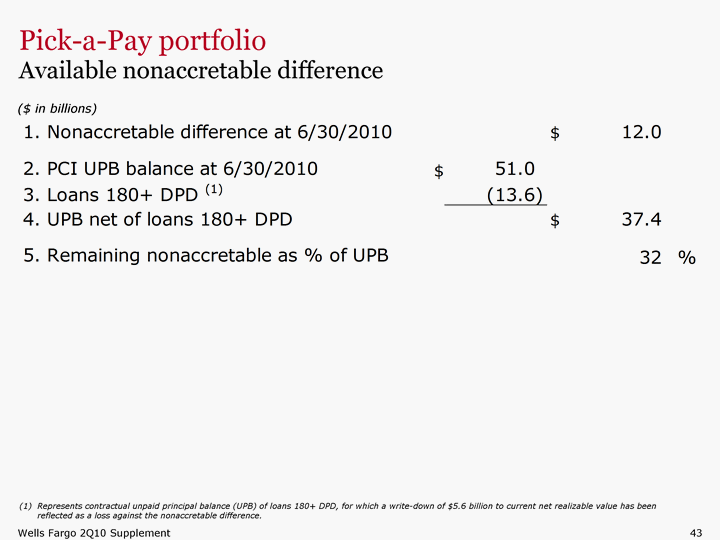
| Pick-a-Pay portfolio Available nonaccretable difference Represents contractual unpaid principal balance (UPB) of loans 180+ DPD, for which a write-down of $5.6 billion to current net realizable value has been reflected as a loss against the nonaccretable difference. ($ in billions) |
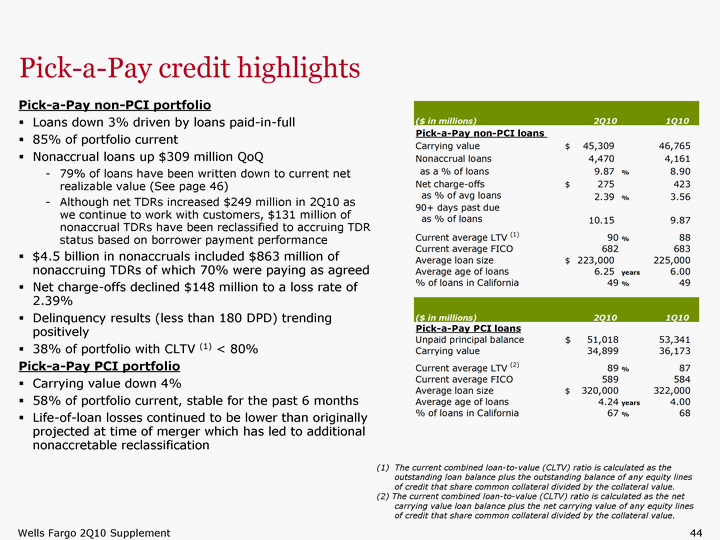
| Pick-a-Pay credit highlights Pick-a-Pay non-PCI portfolio Loans down 3% driven by loans paid-in-full 85% of portfolio current Nonaccrual loans up $309 million QoQ 79% of loans have been written down to current net realizable value (See page 46) Although net TDRs increased $249 million in 2Q10 as we continue to work with customers, $131 million of nonaccrual TDRs have been reclassified to accruing TDR status based on borrower payment performance $4.5 billion in nonaccruals included $863 million of nonaccruing TDRs of which 70% were paying as agreed Net charge-offs declined $148 million to a loss rate of 2.39% Delinquency results (less than 180 DPD) trending positively 38% of portfolio with CLTV (1) < 80% Pick-a-Pay PCI portfolio Carrying value down 4% 58% of portfolio current, stable for the past 6 months Life-of-loan losses continued to be lower than originally projected at time of merger which has led to additional nonaccretable reclassification The current combined loan-to-value (CLTV) ratio is calculated as the outstanding loan balance plus the outstanding balance of any equity lines of credit that share common collateral divided by the collateral value. (2) The current combined loan-to-value (CLTV) ratio is calculated as the net carrying value loan balance plus the net carrying value of any equity lines of credit that share common collateral divided by the collateral value. |
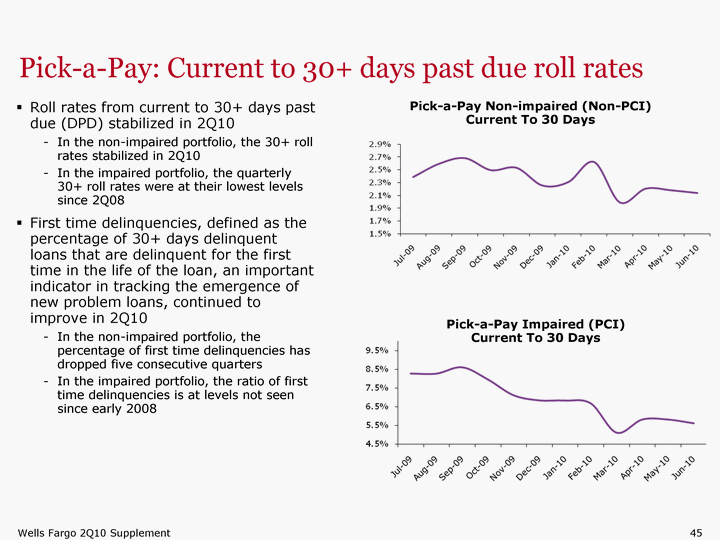
| Pick-a-Pay Non-impaired (Non-PCI) Current To 30 Days Pick-a-Pay Impaired (PCI) Current To 30 Days Pick-a-Pay: Current to 30+ days past due roll rates Roll rates from current to 30+ days past due (DPD) stabilized in 2Q10 In the non-impaired portfolio, the 30+ roll rates stabilized in 2Q10 In the impaired portfolio, the quarterly 30+ roll rates were at their lowest levels since 2Q08 First time delinquencies, defined as the percentage of 30+ days delinquent loans that are delinquent for the first time in the life of the loan, an important indicator in tracking the emergence of new problem loans, continued to improve in 2Q10 In the non-impaired portfolio, the percentage of first time delinquencies has dropped five consecutive quarters In the impaired portfolio, the ratio of first time delinquencies is at levels not seen since early 2008 |
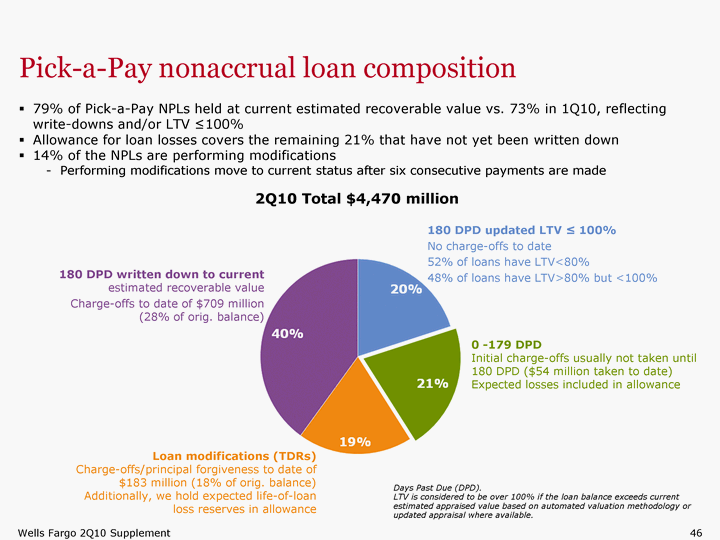
| Pick-a-Pay nonaccrual loan composition 79% of Pick-a-Pay NPLs held at current estimated recoverable value vs. 73% in 1Q10, reflecting write-downs and/or LTV ^100% Allowance for loan losses covers the remaining 21% that have not yet been written down 14% of the NPLs are performing modifications Performing modifications move to current status after six consecutive payments are made 2Q10 Total $4,470 million 180 DPD written down to current estimated recoverable value Charge-offs to date of $709 million (28% of orig. balance) 180 DPD updated LTV ^ 100% No charge-offs to date 52% of loans have LTV<80% 48% of loans have LTV>80% but <100% 0 -179 DPD Initial charge-offs usually not taken until 180 DPD ($54 million taken to date) Expected losses included in allowance Loan modifications (TDRs) Charge-offs/principal forgiveness to date of $183 million (18% of orig. balance) Additionally, we hold expected life-of-loan loss reserves in allowance Days Past Due (DPD). LTV is considered to be over 100% if the loan balance exceeds current estimated appraised value based on automated valuation methodology or updated appraisal where available. |
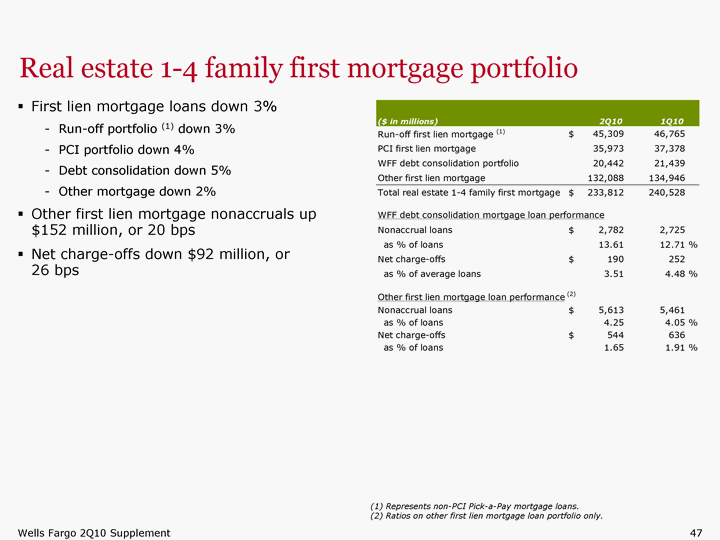
| Real estate 1-4 family first mortgage portfolio First lien mortgage loans down 3% Run-off portfolio (1) down 3% PCI portfolio down 4% Debt consolidation down 5% Other mortgage down 2% Other first lien mortgage nonaccruals up $152 million, or 20 bps Net charge-offs down $92 million, or 26 bps (1) Represents non-PCI Pick-a-Pay mortgage loans. (2) Ratios on other first lien mortgage loan portfolio only. |
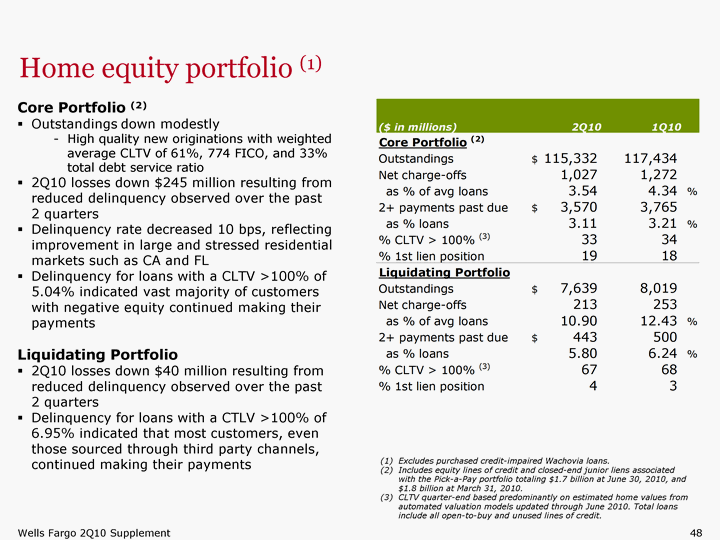
| Home equity portfolio (1) Core Portfolio (2) Outstandings down modestly High quality new originations with weighted average CLTV of 61%, 774 FICO, and 33% total debt service ratio 2Q10 losses down $245 million resulting from reduced delinquency observed over the past 2 quarters Delinquency rate decreased 10 bps, reflecting improvement in large and stressed residential markets such as CA and FL Delinquency for loans with a CLTV >100% of 5.04% indicated vast majority of customers with negative equity continued making their payments Liquidating Portfolio 2Q10 losses down $40 million resulting from reduced delinquency observed over the past 2 quarters Delinquency for loans with a CTLV >100% of 6.95% indicated that most customers, even those sourced through third party channels, continued making their payments (1) Excludes purchased credit-impaired Wachovia loans. (2) Includes equity lines of credit and closed-end junior liens associated with the Pick-a-Pay portfolio totaling $1.7 billion at June 30, 2010, and $1.8 billion at March 31, 2010. (3) CLTV quarter-end based predominantly on estimated home values from automated valuation models updated through June 2010. Total loans include all open-to-buy and unused lines of credit. |
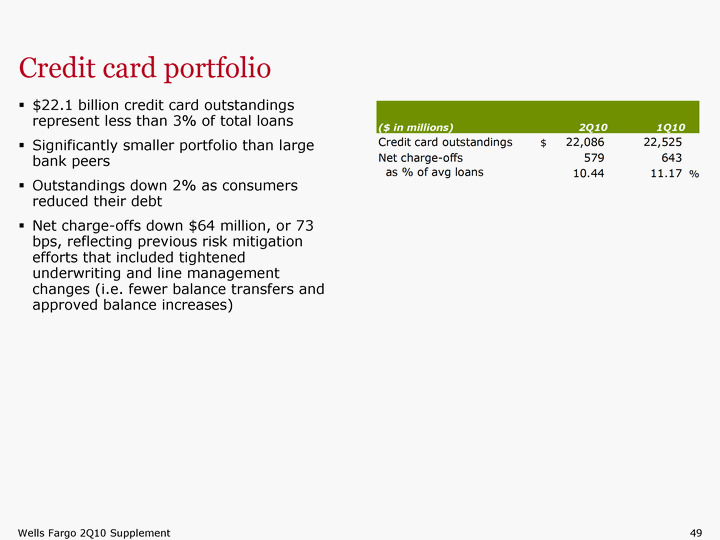
| Credit card portfolio $22.1 billion credit card outstandings represent less than 3% of total loans Significantly smaller portfolio than large bank peers Outstandings down 2% as consumers reduced their debt Net charge-offs down $64 million, or 73 bps, reflecting previous risk mitigation efforts that included tightened underwriting and line management changes (i.e. fewer balance transfers and approved balance increases) |
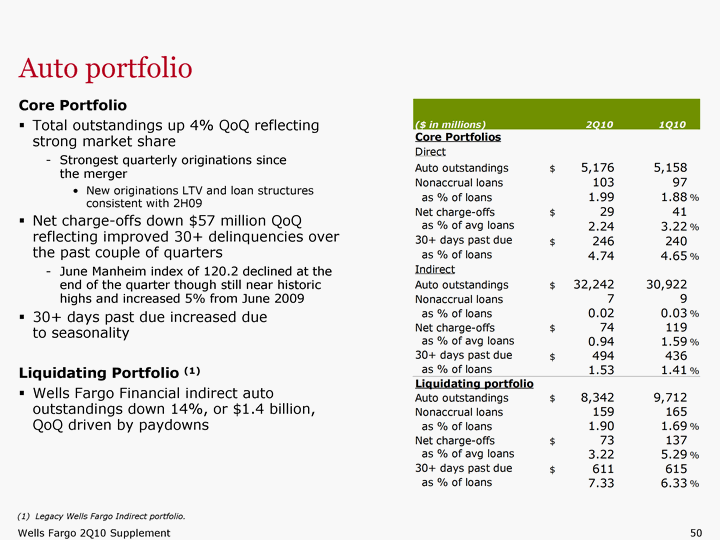
| Auto portfolio Core Portfolio Total outstandings up 4% QoQ reflecting strong market share Strongest quarterly originations since the merger New originations LTV and loan structures consistent with 2H09 Net charge-offs down $57 million QoQ reflecting improved 30+ delinquencies over the past couple of quarters June Manheim index of 120.2 declined at the end of the quarter though still near historic highs and increased 5% from June 2009 30+ days past due increased due to seasonality Liquidating Portfolio (1) Wells Fargo Financial indirect auto outstandings down 14%, or $1.4 billion, QoQ driven by paydowns Legacy Wells Fargo Indirect portfolio. |
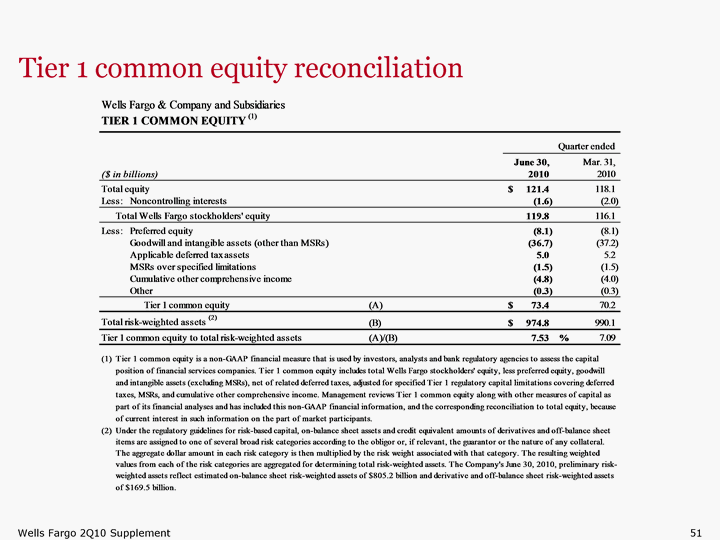
| Tier 1 common equity reconciliation |
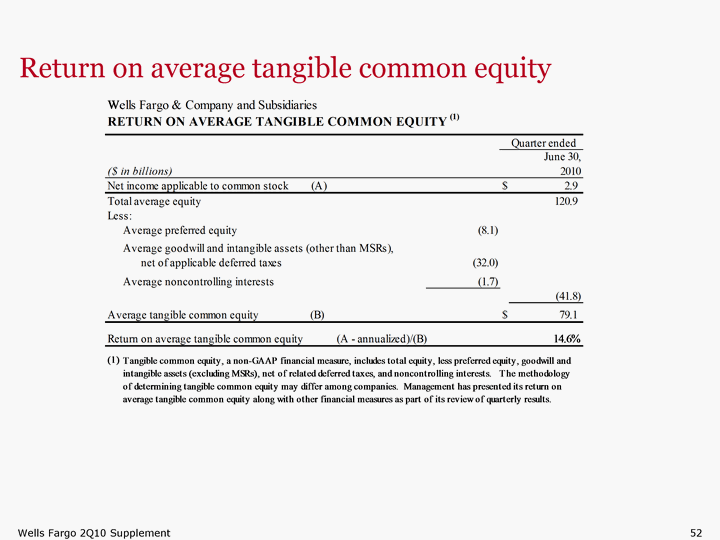
| Return on average tangible common equity |
